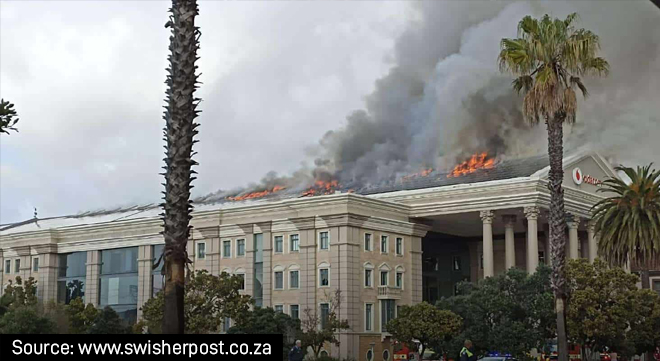A blaze that broke out at the Vodacom Building in Century City, Western Cape, has lit a fire under the City of Cape Town and South Africa’s largest insurer to inform business- and homeowners of the risks of alternative power sources.
Just after 11am on 9 July, the City’s Fire and Rescue Service was alerted that solar panels were on fire on the roof of the building. It took the responding crews until 4pm to extinguish the fire. While no one was hurt, the building was left with a gutted roof.
Fire and Rescue Service spokesperson Jermaine Carelse said the cause of the fire was still under investigation.
He said the extent of the damage would have to be confirmed by the building owner. “But from the initial on-scene indications, once the fire had been extinguished late on Sunday, it was evident that the building had sustained substantial damage,” Carelse said.
Vodacom spokesperson Byron Kennedy said it was too soon to comment on the extent of the damage.
“The building was successfully evacuated, and no injuries were sustained as a result of the incident. An investigation is now under way to determine the cause of the fire, which has not yet been established.”
Risk factor
According to statistics provided by a local solar provider, South African households imported more than R2.2 billion worth of solar photovoltaic (PV) panels in the first five months of 2022. Considering the country’s energy crisis – and a tax rebate of 25% (to a maximum of R15 000) on the cost of panels from 1 March 2023 – it is fair to say that this upward trajectory is likely to continue.
Listing a handful of incidents that occurred in recent times, the City issued a media statement last week, informing users of the need to be cautious and vigilant about how they use and store energy devices.
Carelse said it is imperative to ensure that installations of solar panels, inverters and even generators or gas supplies are done by accredited installers.
“And that these devices are installed in areas that have good ventilation, as batteries can overheat and ignite. A build-up of fumes from petrol, diesel or gas can also result in explosions or persons being overcome by toxic fumes,” he said.
To minimise the potential damage, municipalities require all solar PV and/or battery systems to be installed by a competent installer who must provide a Certificate of Compliance (CoC).
Mayco member for safety and security JP Smith said all systems that are connected to the wiring of the building must be registered with the City before installation and, from October, only City-approved inverters will be accepted for these systems.
“This is to reduce the risk of electrocution of those working on electrical grids and to speed up the solar system authorisation turnaround time,” Smith said.
Undercover
Not only is a CoC required by law and for the registration of the solar power generating system with the relevant municipality, it is also a must when insurance cover comes into play.
Marius Steyn, the personal lines underwriting manager at Santam, says it is important to do your homework and hire a reputable installer to avoid risks such as fire and explosion brought on by sub-standard or non-compliant installation.
“Insurers generally do not cover damages resulting from implementation flaws or poor workmanship,” cautions Steyn.
He further explains that damage caused to the roof because of the installation is excluded in general. He says that loss or damage caused by demolition, alteration, construction, cleaning, renovation, repairs, restoration, or similar processes are generally excluded under the buildings section of a policy.
This represents another risk to consider – being underinsured in the event of a claim.
Solar power systems are fixed to a property. Hence, they form part of a homeowner’s building insurance cover. Steyn advises those who have upgraded their properties with a solar system to contact their insurer and increase their building insurance sum insured to cover the cost of the solar assets installed.
“When a solar power system is installed, it influences the value of the building and, therefore, the building sum insured should be increased to accommodate the value of the investment in the solar power system. If the insured value of the building is not equal to the current replacement value, underinsurance (principle of average) could be applicable in the event of a claim and the claim will not be paid in full,” explains Steyn.
Identifying a reputable installer
Steyn advises looking for credentials such as references of previous work and how long the business has been in operation. A reputable installer should provide a comprehensive quote detailing the scope of work, components that will be used in the installation as well as, importantly, after-sales services, warranties, and guarantees.
It should also advise you of any potential issues that may compromise the installation and functioning of the solar power system before commencing the installation.
If your building is damaged during the installation process, this should be covered by the installer under their Contractors All Risk Insurance policy. A pre-installation inspection is crucial to ascertain that the building’s roof structure and rafters are not compromised, rotten or damaged so that the solar panel installation can be carried out.



